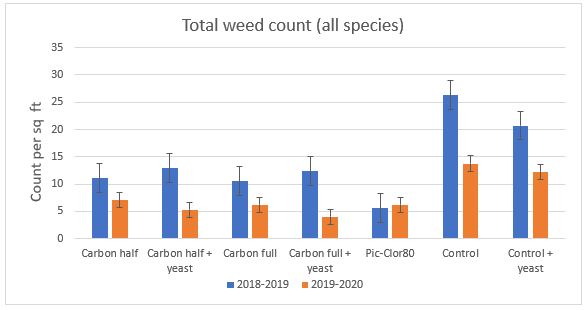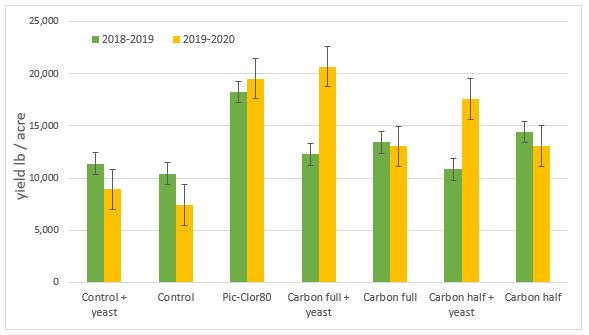Danyang Liu and Jayesh B. Samtani, Hampton Roads Agricultural Research and Extension Center, Virginia Tech
The southern region is the second-largest strawberry-growing region of the United States. Strawberry plants are susceptible to soil-borne pests, including weeds and diseases. Early season weeds can compete with newly transplanted strawberry plugs for nutrients, light, and other resources. There are limited options of preplant fumigants and herbicides available for use in strawberry plasticulture production making weed control a challenge. Anaerobic soil disinfestation (ASD) may be an effective alternative to preplant chemical fumigation. Anaerobic soil disinfestation involves three steps- applying carbon sources to the soil, covering the bed with an impermeable tarp, and watering the soil to maintain soil moisture to field capacity, generally for 21 days.
There are only a few studies in the U.S. to date, evaluating ASD effects on weed control. Carbon sources local to our region also need to be evaluated for their use in ASD. Our initial study in greenhouse conditions focused on evaluating locally available carbon sources for ASD and showed brewers’ spent grain (BSG) to be of promise. This study also explored a new approach of mixing distiller’s yeast with solid carbon sources to enhance the ASD weed control effect. Additionally, this study evaluated the effect of ASD using reduced carbon inputs, thus potentially reducing the total cost of ASD. A follow-up, replicated, field study during the 2018-2019 and 2019-2020 growing seasons done at the Hampton Roads Agricultural Research and Extension Center evaluated BSG at full rate with or without yeast. However, the total nitrogen from brewer`s spent grain (C: N ratio 14: 1) was much higher than the soil test recommendation for strawberry production. Thus, to reduce the nitrogen coming from the carbon source, the brewer`s spent grain was mixed with pelleted paper mulch (C: N ratio 57:1). Fumigation (Pic-Clor 80 at 175 lb/acre) treatment was used for comparison. We evaluated the effects of these treatments on weed control, plant crop growth, and crop yields for Ruby June strawberry variety.
Over both seasons, plots treated with all ASD treatments consistently and significantly had a lower density of most of the broadleaf weed species and total weed density compared to non-treated plots (Figure 1). In both growing seasons, the dominant broadleaf weeds species observed in the study were carpetweed, Carolina geranium, cudweed, henbit, and white clover. The dominant grass weed species were bermudagrass and crabgrass. Shepherd’s purse and yellow nutsedge were dominant species only in the 2018-19 growing season but not the latter growing season. Compared to Pic-Clor 80, ASD treatments had similar control on cudweed, henbit, and white clover, but better control of Carolina geranium. Pic-Clor 80 had better control of carpetweed than ASD. Strawberry marketable and total yield in the 2018-19 growing season was not significantly different among all ASD treatments and non-treated control, but all ASD treated plots had a higher marketable and total yield than non-treated control in 2019/20. In the 2019-20 growing season, yeast addition enhanced the crop yield of the ASD treatments compared to ASD treatments without yeast (Figure 2). Compared to plots treated with Pic-Clor 80, ASD treated plots in the 2018-19 growing season had lower total yield. However, in the 2019-20 growing season, plots with ASD at both rates with yeast had similar yield compared to Pic-Clor 80 treated plots. Therefore, the yeast amendment had the potential to enhance ASD using brewer’s spent grain and paper mulch as carbon sources for weed control and improvement of strawberry yield. Half carbon rate of ASD with yeast could be a potential strategy to reduce the cost of ASD.
This study was funded in part by the Southern Region Small Fruit Consortium and North American Strawberry Growers Association.

